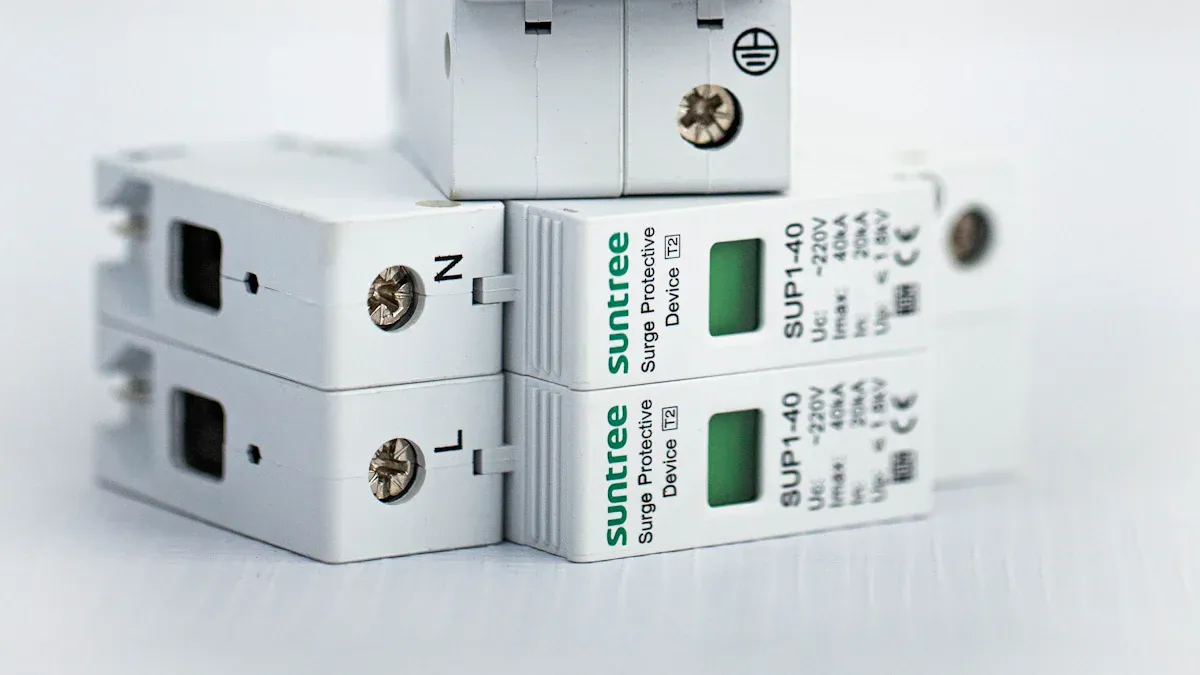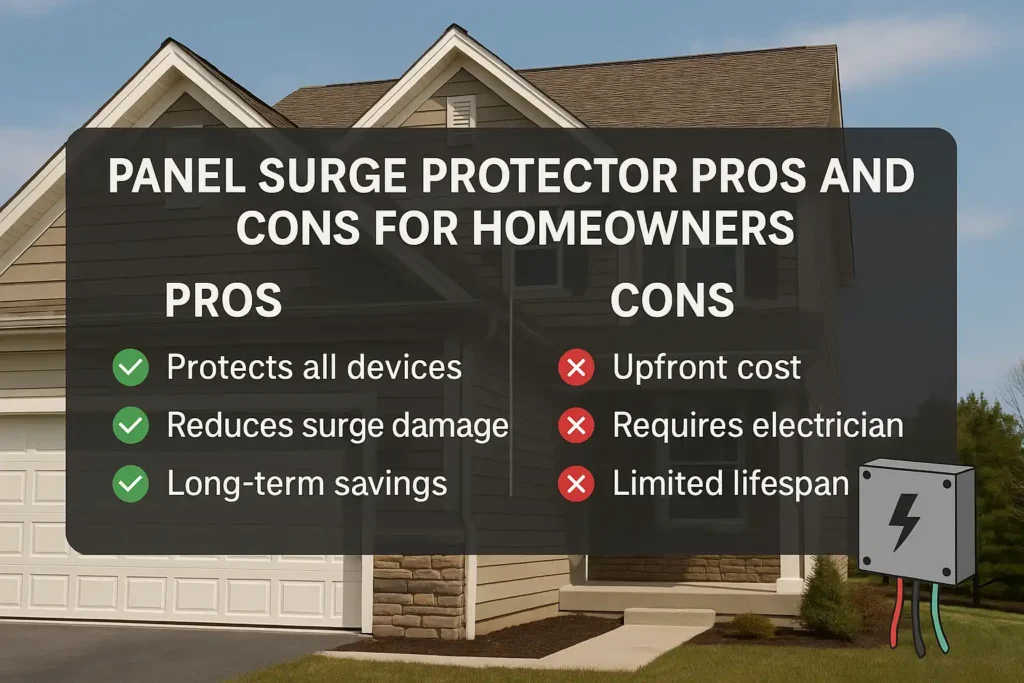If you want to keep your home electronics safe, a panel surge protector helps a lot. It protects all devices that are wired in, like HVAC systems and water heaters. Power strips cannot do this. Many people have up to $20,000 in electronics that could be damaged by small surges. You also make it less likely to have an electrical fire. Electrical fires cause about 46,700 house fires every year.
| Fact | What It Means for You |
|---|---|
| Up to 80% of surges start inside your home | Most dangers come from using appliances every day |
| $100,000 warranty available | Some protectors give strong promises for your devices |
| NEC 2020 code requires surge protection in new homes | Shows that safety is becoming more important |
You should think about these good things and also the cost and need for a professional to install it.
Key Takeaways
- A panel surge protector keeps your whole house safe. It stops dangerous voltage spikes from hurting your devices and appliances.
- Using a panel surge protector lowers the chance of electrical fires. It also helps your expensive appliances last longer.
- You need a professional to install it. Good home grounding is also important for it to work well and safely.
- No surge protector can stop every surge. Using both a panel protector and plug-in protectors is the best way to protect sensitive electronics.
- You should check your surge protector often. Look at the indicator lights to make sure it works. This helps keep your home safe for a long time.
What Is It?
How It Works
A panel surge protector is put in your main electrical panel. Its job is to stop dangerous voltage spikes from reaching your electronics. When a surge happens, it finds the extra voltage and sends it safely to the ground. This helps keep your devices from getting ruined.
Inside a panel surge protector, there are several important parts. Each part does something special:
| Component | What It Does |
|---|---|
| Discharge Gap | Makes a safe way for extra voltage to leave. |
| Gas Discharge Tube | Uses gas to move away big surges when voltage is too high. |
| Varistor | Changes how it works to quickly take in and move surges. |
| Suppression Diode | Stops and limits voltage spikes as a last defense. |
| Choke Coil | Cuts down on electrical noise and stops interference. |
All these parts work together to find surges and send extra energy away from your home’s wires. For example, a varistor acts very fast to stop a spike, and a gas discharge tube handles big surges like lightning. The grounding system is also very important. It gives the surge a safe way out of your house.
Panel surge protectors come in a few types. Type 1 protectors go between the utility line and your main panel. Type 2 protectors are inside the panel and handle surges from inside or outside your home. Type 3 protectors plug into outlets for extra safety on sensitive devices.
Tip: Always look for UL 1449 certification when picking a panel surge protector. This shows it meets strong safety rules.
What It Protects
A panel surge protector guards almost every device hooked up to your home’s electrical system. You get protection for:
- Refrigerators and freezers
- HVAC systems and water heaters
- Home entertainment systems
- Smart switches and home automation devices
- Security systems and medical monitoring equipment
- Computers, phones, and laptops
You also protect smaller gadgets and appliances that plug into outlets. The protector stops surges from problems with the grid, lightning, or big appliances turning on and off. Some sensitive electronics, like old smart switches, might still need extra point-of-use protection.
Panel surge protectors help you avoid expensive repairs and make your home safer from electrical fires. They work best when a professional puts them in and checks them often.
Panel Surge Protector Benefits

Whole-Home Coverage
A panel surge protector acts like a shield for your whole house. It protects every device and system linked to your electrical panel. This means not just special outlets get protection. Your lights, outlets, and appliances are all covered. Even hard-wired systems like security alarms are safe.
- You stop damage from lightning and power company issues. Surges from your own appliances turning on and off are blocked too. Your home’s wiring and safety devices stay safe from sudden voltage spikes. You do not need to use many small surge protectors everywhere.
Tip: A licensed electrician should install your surge protector. This makes sure it works right and keeps your home safe.
Protects Large Appliances
Big appliances are expensive to fix or replace. A surge can ruin the control boards in your refrigerator or oven fast. Even small surges can slowly damage these machines.
- A panel surge protector blocks both big and small surges. It sends extra voltage safely to the ground. Your washer, dryer, and other big machines stay safe. You avoid sudden breakdowns and costly repairs. Your appliances last longer and work better.
Reduces Fire Risk
Electrical fires can start if wires get too hot from too much voltage. Surges make this more likely, especially with old wiring or lots of devices running.
- Surge protectors keep voltage spikes under control. Wires do not get too hot. You lower the chance of sparks or overheating that can cause fires. Important safety systems like smoke alarms and security devices stay safe during a surge.
Note: New safety codes now say surge protection is needed in many new homes. This shows how important it is for stopping fires.
Extends Device Lifespan
Every surge hurts your electronics and appliances a little. Over time, this makes them break down faster.
- Surge protectors cut down on damage from voltage spikes. You have fewer repairs and replacements for your devices. Studies show homes with surge protection have fewer equipment failures. Machines last longer too. Regular checks and the right surge protector help you get the most out of your devices.
Other Benefits: Insurance and Peace of Mind
- Many insurance companies want to see surge protectors if you file a claim after a lightning strike or power surge. Having a panel surge protector and proof of professional installation helps your claim go smoothly. Some surge protectors have warranties that cover damage. This gives you extra financial security. You feel better knowing your home and electronics have strong protection.
Peace of mind: You save money by avoiding expensive repairs and replacements. You also know your home is safer from fires and electrical problems.
Panel Surge Protector Limitations

Upfront Cost
You will see the upfront cost right away. Most people pay $300 to $700 for the device and installation. The price can be higher if your panel needs an upgrade or your house is old. Labor costs are usually $50 to $100 each hour. You might also pay for permits or inspections.
| Cost Component | Typical Cost Range | Notes |
|---|---|---|
| Whole-house surge protector | $300 – $700 | Includes professional installation; depends on SPD type, installation complexity, location |
| Labor | $50 – $100 per hour | Installation usually takes a couple of hours |
| Electrical panel upgrade | $500 – $2,000+ | Depends on panel capacity and home size |
| Permits | $10 – $500 | Local building codes may require permits |
| Electrical inspection | $100 – $400 | Required for code compliance |
| Type 3 surge protectors | $10 – $25 | Cheaper, limited protection, no professional installation needed |
Plug-in surge protectors cost less, about $15 to $50 each. But they do not protect hardwired things like your HVAC or oven. If you want to protect everything, you may need many plug-in units. This can cost more over time.
Note: Always have a pro install your panel surge protector. This keeps you safe and makes sure you follow the rules.
Grounding Dependence
A panel surge protector only works if your home has good grounding. The device sends extra voltage into the ground. If your grounding is weak or old, it cannot work right.
- Surge protectors need a direct, low-resistance path to the ground.
- Electricians use thick copper wires to help lower resistance.
- The NEC has rules for grounding. Your setup must follow these rules.
- Old wiring may need upgrades before you add a surge protector.
Tip: Have a licensed electrician check your grounding first. Good grounding keeps your surge protector working and your home safe.
Not 100% Effective
No surge protector can stop every surge. Even the best panel surge protector cannot block all surges. Direct lightning or huge surges can still hurt your devices. Some surges are just too strong.
- Surge protectors work best for normal surges from appliances.
- Very strong surges, like lightning, can be too much for them.
- Some electronics, like computers, need extra protection.
Use point-of-use surge protectors for your most important electronics. These plug-in devices stop surges at lower levels. This gives you another layer of safety. Experts say to use both whole-home and point-of-use protection for the best results.
| Protection Level | What It Covers | Best Use |
|---|---|---|
| Panel surge protector | Whole house, hardwired appliances | General protection, large surges |
| Point-of-use surge protector | Individual outlets, sensitive electronics | Extra protection for computers, TVs, smart devices |
Alert: Using more than one kind of surge protection lowers your risk. No single device can protect everything.
Maintenance Needs
Panel surge protectors need regular care to keep working well. They wear out after handling many surges. You should check the lights on your device. If the light goes out or shows a problem, you need to replace it or call an electrician.
- Plan regular checks to look for damage or wear.
- Replace the surge protector after it takes several surges or gets old.
- Only certified electricians should do repairs or replacements.
- Some homes need tests to make sure the system works right.
- Homeowners should learn how to watch their surge protector and spot problems early.
Reminder: If you skip maintenance, your home may not be protected. Make surge protector checks part of your home safety routine.
Comparison
Panel Surge Protector vs. Power Strip
Some people think power strips keep electronics safe from surges. Most power strips just give more places to plug things in. They might have a simple breaker, but not real surge protection. Power strips usually do not show a joule rating. This means you cannot know how much energy they can take.
A panel surge protector works in a different way. It is put in your main electrical panel and protects your whole house. It uses special parts like metal oxide varistors and gas discharge tubes. These parts notice voltage spikes and send extra energy away from your devices. You can see a joule rating and clamping voltage on these protectors. The joule rating tells how much energy the device can take before it stops working. The clamping voltage shows the highest voltage your devices will get during a surge. If the device meets UL rules, this is usually under 400 volts.
Both types of surge protectors get weaker after many surges. But only a panel surge protector can protect hardwired appliances and every outlet at once. Power strips cannot do this.
| Feature | Power Strip | Panel Surge Protector |
|---|---|---|
| Surge Protection | Rare or limited | Yes, whole-home |
| Joule Rating | Usually missing | Clearly listed |
| Clamping Voltage | Not specified | UL standard (≤400V) |
| Protects Hardwired | No | Yes |
| Installation | Plug-in | At main panel (pro only) |
Tip: Always look for UL certification when picking any surge protection device.
When to Use Each
Pick a panel surge protector if you want to keep your whole home safe. This is important if you have costly appliances or live where storms happen a lot. Experts say you should match the surge protector’s ratings to your home. UL LISTED devices help you pass inspections and save money.
Use power strips with surge protection for extra safety on things like computers or TVs. These are good for single devices or small groups of electronics. Always check if the power strip really has surge protection, not just more outlets.
- Pick a panel surge protector for:
- Whole-home coverage
- Hardwired appliances
- Meeting new building codes
- Pick a surge-protecting power strip for:
- Extra protection for computers, TVs, or gaming systems
- Places where you cannot put a panel device
Remember: The best way to protect your stuff is to use both—a panel surge protector for your main defense and surge-protecting power strips for your most sensitive devices.
Is It Right for You?
Key Factors
When you think about whole-house surge protection, look at a few main things. Every house is different, so you need to decide what is most important for you.
- Type of surge protector: Type 2 works best for most homes.
- Joule rating: A higher number means it can take in more energy and gives better protection.
- Clamping voltage: A lower number means your devices get protected faster.
- Response time: If it reacts quickly, your electronics are safer.
- Indicator lights: These lights show if your surge protector still works.
- Warranty: A good warranty helps you feel safe if something fails.
- Installation: Some protectors need their own breaker or more room in your panel.
- Smart features: Some have remote checks or work with smart home systems.
- Local weather: If you get lots of storms or lightning, you need a stronger device.
- Maintenance: Plan to check and replace your surge protector every few years.
Tip: Always have a licensed electrician look at your home’s grounding and panel before you add surge protection.
Typical Scenarios
You should think about surge protection if these things sound like you:
- You have lots of expensive electronics or smart appliances.
- You use solar panels, energy storage, or charge electric cars.
- Your area has many storms or power problems.
- You want to lower the chance of fire or damage from surges.
- Your insurance company asks for surge protection.
- You want to keep computers, medical gear, or security systems safe.
- You plan to add more smart tech to your home soon.
Many homeowners see that whole-house surge protection is a good idea, especially as homes use more tech and power surges happen more often.
You get good protection for your home’s electronics. But you will pay more money at first and need to do upkeep. Look at the table below for a quick look:
| Aspect | Pros | Cons |
|---|---|---|
| Protection | Keeps devices safe from power surges | Might not work with very strong voltage |
| Cost/Install | Can save money on repairs later | Costs more at first, needs a pro to install |
| Maintenance | Works well with high currents if rated | Needs to be checked often, can wear out |
- Make sure your home’s grounding is good before you start.
- Use both whole-house and plug-in surge protectors for better safety.
- Read the warranty and have good insurance.
- Talk to a licensed electrician to get the best setup.
Think about your risks and what you need before you decide if this is right for your home.
FAQ
How long does a panel surge protector last?
Most panel surge protectors last 5 to 10 years. You should check the indicator lights often. If the light goes out or changes color, you need to replace the device.
Can you install a panel surge protector yourself?
You should not install it yourself. Only a licensed electrician should do this job. This keeps you safe and makes sure the device works right.
Do you still need plug-in surge protectors?
Yes, you do. Panel surge protectors help with big surges, but plug-in protectors give extra safety for sensitive electronics like computers and TVs.
Will a panel surge protector stop lightning damage?
A panel surge protector can help lower the risk, but it cannot stop a direct lightning strike. You should unplug devices during big storms for the best safety.
How do you know if your surge protector is working?
Look for a green or “protected” light on the device. If the light is off or red, call an electrician to check or replace it.
The following information may be of interest to you
Do you need a surge protector for your solar system
How to Replace a Surge Protector Safely and Efficiently
What You Need to Know About Surge Protection Device Lifespan
Is the location of installing surge protectors important?



